#major manuel bernal
Text

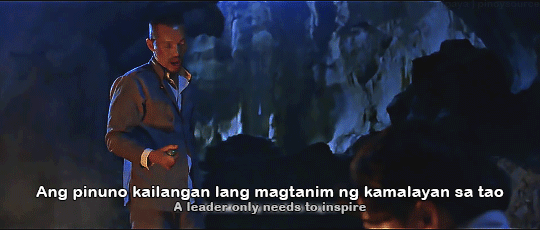



Bakit "idolo" ang tawag niyo sa presidente? Hindi ba dapat "pinuno"?
Why do you keep calling the President an "idol"? Shouldn't he be called a "leader"?
ANGELITO (2018)
#angelito#heneral luna#goyo: ang batang heneral#jerrold tarog#joven hernando#major manuel bernal#captain jose bernal#aaron villaflor#art acuña#alex medina#philippines#angelitoedit#perioddramaedit#philippine cinema#filipino films#2010s#*angelito (2018)#userligaya#pinoysource#filogifs
45 notes
·
View notes
Text
GENERAL MATHEMATICS
STOCK AND BONDS

the goods or merchandise kept on the premises of a business or warehouse and available for sale or distribution.

What are bonds? A bond is a debt security, similar to an IOU. Borrowers issue bonds to raise money from investors willing to lend them money for a certain amount of time. When you buy a bond, you are lending to the issuer, which may be a government, municipality, or corporation.

Choosing the right mix of stocks and bonds can be one of the most basic yet confusing decisions facing any investor. In general, the role of stocks is to provide long-term growth potential and the role of bonds is to provide an income stream.
PHILIPPINE POLITICS AND GOVERNANCE
HENERAL LUNA

Because of his bravery, Luna was named director of War on September 26, 1898. He became famous for bravery, unusual style of fighting, and strict discipline. At the age of 31, he was shot dead on June 5, 1899 in Cabanatuan City in an attack led by a disgruntled Filipino Sergeant.
Heneral Luna (lit. 'General Luna') is a 2015 Filipino historical biopic film depicting General Antonio Luna's leadership of the Philippine Revolutionary Army during the Philippine–American War. Directed by Jerrold Tarog and produced by Artikulo Uno Productions, the film received critical acclaim from critics, praising its cinematography, writing, acting and plot. The film was selected as the Philippine entry for the Best Foreign Language Film at the 88th Academy Awards but it was not nominated.
Spain's colonial rule of the Philippines ends in 1898. Unwilling to surrender to the Filipinos, they sell the archipelago for $20 million. While the Americans prepare to claim their latest colony, the Filipinos argue amongst themselves, unaware of their country's fate under the Treaty of Paris.
In December 1898, at the Barasoain Church, a cabinet meeting over the American presence in the Philippines leads to ilustrados Felipe Buencamino and Pedro Paterno proposing an alliance with the Americans as its protectorate, angering General Antonio Luna and José Alejandrino, who want to continue the revolution for independence. They are wary of the presence of American forces in the country, believing another imperialist nation will replace the Spanish. They are concerned about the latest American orders barring Filipino troops out of the walled city of Intramuros (the government's seat and power base of the Spanish) since the recent Battle of Manila.
Luna asks the Cabinet to authorize a pre-emptive strike to take control of Intramuros while possible. Prime Minister Apolinario Mabini warns the cabinet of the 7,000 additional American reinforcements arriving to quell any insurgencies. The generals want to strike immediately in a patriotic intent. Meanwhile, Filipino President Emilio Aguinaldo continues American peace and trade negotiations, sending Buencamino and Paterno to meet them, assuring his cabinet that the Americans promise to help win freedom from their Spanish overlords. However prior on August 13, the Spanish and Americans plotted the Battle of Manila[12] to transfer control of Intramuros to the latter. On December 10, 1898, the Spanish–American War ends. With Intramuros' authority being on the Americans, they invade Santa Mesa, San Juan, Paco and Pandacan, attacking any Filipino resistance.
Luna and his trusted officers–General José Alejandrino, Colonel Francisco “Paco” Román, Captain Eduardo Rusca, Captain José Bernal and Major Manuel Bernal–begin an arduous campaign against the Americans. During a battle, Luna asks for reinforcements from the Kawit battalion but commander Captain Pedro Janolino refuses since the order did not come from Aguinaldo. Luna slams him, declaring his infamous "Article One" which states that those refusing to follow his orders shall be executed on the spot. Amid a new battle, Buencamino and Paterno reiterate their protectorate proposal, prompting Luna to arrest them as traitors to the constitution. Meanwhile, Luna's campaign is undermined by General Tomás Mascardo, who opposes his order similarly with Janolino. While the two generals are about to clash in Pampanga, the Americans advance steadily as other Filipino generals like Gregorio del Pilar retreat to the north. Luna demands resignation, knowing that Buencamino and Paterno have been set free. Aguinaldo refuses, approving his request to establish a northern headquarters.
Later, Luna is summoned to the President's headquarters in Cabanatuan. Luna visits with Román and Rusca despite the suspicions among the officers. Upon arrival, he discovers that Aguinaldo had left, with Buencamino the only cabinet member remaining. Luna then encounters Janolino and his men, who kill him. Román is also killed when attempting to aid his commander while a wounded Rusca surrenders. Most of Luna's officers are arrested, while some are tortured and killed, including the Bernal brothers, Luna's closest aides. Aguinaldo requests Luna and Román be buried with full military honors by the Kawits. Mabini notices a bloody machete on one of the men, however the killers are never caught. After the war, Aguinaldo denies his involvement on the assassination; calling Luna his most brilliant and capable general. Meanwhile, General Gregorio del Pilar prepares to cover Aguinaldo's retreat to the north. He inspects Luna's remaining men and orders his aide, Colonel Vicente Enríquez to select 60 of them.
EARTH AND LIFE SCIENCE
ORGAN SYSTEM OF REPRESENTATIVE OF ANIMALS

The respiratory system is a biological system consisting of specific organs and structures used for gas exchange in animals and plants. The anatomy and physiology that make this happen varies greatly, depending on the size of the organism, the environment in which it lives and its evolutionary history.

The urinary system, also known as the urinary tract or renal system, consists of the kidneys, ureters, bladder, and the urethra. The purpose of the urinary system is to eliminate waste from the body, regulate blood volume and blood pressure, control levels of electrolytes and metabolites, and regulate blood pH.

The endocrine system is a complex network of glands and organs. It uses hormones to control and coordinate your body's metabolism, energy level, reproduction, growth and development, and response to injury, stress, and mood. The following are integral parts of the endocrine system: Hypothalamus.

The blood circulatory system is a system of organs that includes the heart, blood vessels, and blood which is circulated throughout the entire body of a human or other vertebrate. It includes the cardiovascular system, or vascular system, that consists of the heart and blood vessels.
1 note
·
View note
Text
Repent (A “GOYO: Ang Batang Heneral” one-shot)
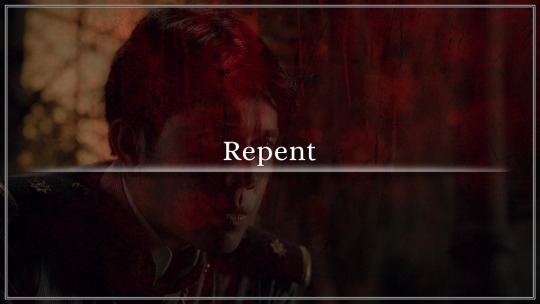
Goyo, at his death, knew that he was a monster for all the wrong things he had done. If he could do something against it, surely he already done so... and he was given the chance to make peace of it. Finally accepting the truth that he was much less than a human to be heralded as a hero.
They said that the life of a person flashes before ones’ eyes just before death. But there were others whose life was so short to even give too much of something to be guilty of. The longer ones’ life was, the more memories to be seen.
It was different for Goyo. Despite his young age, he had seen too much. Enough to be guilty about. Enough to know that he was to expect the ground opening up beneath him and to swallow him whole.
However, what he had seen was so different compared to what he expected after that bullet killed his physical body, forcing his soul to leave that empty and broken shell, seeing for himself how ugly and gore he appeared back then, and be brought to a world too different from what was known of by the living.
As a child, he believed that the deceased souls went there to the Heavens. When he grew up, he had that theory that the dead were those birds who evaded gravity for the magic of flight. But when he joined the revolution, he understood that he could’ve been otherwise dragged to hell.
The whiteness and the vast plain of where he was right now surprised him. He knew his sins and recounted that it would warrant him to suffer for all eternity on hell. But this brightness and warm light appeared like heaven, and it was ironic for him to be here after all he had done. And yet, if this was to be Heaven… where were the angels? The beautiful music of their voices and harps? The glory of them gathered together?
Perhaps, this wasn’t heaven. Goyo knew that he would never be there, so… was this hell? Or was this the boundary line before judgment?
Either way, he was lost.
Goyo dropped to the floor. He sat there, drawing his legs close to his chest like a little child. He rocked on his heels, trying to occupy his thoughts with something else. But the memories of everything he had done, especially the bad ones, remained, drawing tears out of his eyes. After all, he regretted everything.
But it was all too late. There was no other way for him to be sorry for all of it.
“Goyo.”
He immediately snapped his head up upon hearing the voice that called his name. After all, he didn’t expect it to be spoken by that very person standing right in front of him right now. Like him being dressed on just plain and white clothes, the man who appeared right there also does. His tears immediately fell in succession as he knelt on the spot with shaking hands so afraid to touch the man. He mumbled, “Patawad, Manuel. Patawad.” He gulped in hard before continuing, “Tama kang tawagin akong isang aso. Totoo. Isa akong aso. Kasalanan ko ang aming pagkatalo.”
Manuel Bernal crouched right in front of him with a heavy sighed. Goyo didn’t expect him to be here; and he was expectant of an unjustful verdict. But Manuel only told him, “Tumayo ka, Goyo. Hindi ka aso. Isa kang heneral.”
Goyo’s tears came much more in a rush. He shook his head, trying to evade from looking straight into the other’s eyes. “Isa akong asong ulol. Kasalanan ko ito. Hindi ako sundalo.”
Manuel immediately closed his hands around Goyo’s wrist, pulling his hands away from his face and urging him to look straight at the man whom he was greatly sorry to. Goyo was so ashamed of how he looked with those tears but the guilt that swelled in his chest was greater than everything else. Manuel called for him with such urgency on his voice, “Goyong. Makinig ka.”
He bit his lower lip as if that will stop him from crying more and more.
“Binuwis mo ang buhay mo para sa Pilipinas,” Manuel continued with a small smile, placing then a hand onto his shoulder. Clapping him there once, he continued, “Isa kang bayani, Goyo.”
The tears came in a much greater rush this time. Goyo closed his eyes as if that would stop him from crying like a child. He immediately threw his arms around Manuel, hiccuping as he said, “Manuel, patawad! Patawad sa lahat-lahat. Sa lahat-lahat ng aking pagkakamali.”
“Ayos lang iyon, Goyo. Ang mahalaga’y natupad mo ang tungkulin mo bilang isang Pilipino.” Manuel assured him, whispering by his ear. “Isa ka talagang aguila, Goyong.”
SUPPORT MORE OF ONE-SHOTS LIKE THIS:
AO3 >>>>> HERE
WATTPAD >>>>> HERE
FANFICTION >>>>> HERE
CURRENTLY OPEN FOR REQUESTS! DM ME FOR MORE! ;)
For more fanfiction/one-shots: see MASTERLIST
#Goyo: Ang Batang Heneral#Goyo2018#Goyo#Goyong#Gregorio del Pilar#General Goyo#General del Pilar#General Gregorio del Pilar#Manuel Bernal#Major Bernal#Major Manuel Bernal#Fanfiction#One-shot#Philippine History#Philippine Heroes#Philippine-American War#Battle of Tirad Pass#GoyoAngstStories#GoyoAngBatangHeneralStories#ProjectAguilaStories
6 notes
·
View notes
Video
youtube
With the existence of heroes’ portrayals and history drama in the Philippine Cinema, the 2015 biopic film ‘Heneral Luna’ offers another perspective for the Filipino film industry. The film tries to capture the eyes of the youth by picking it as its target market; and as a matter of fact, in cinemas nationwide there is an available discount for students. Fortunately, I am one of those students who were able to watch it on big screen. Undoubtingly, this film has so many to offer and I am truly moved by the film. It is indeed a game changer to the world of our cinema and allow me to tell you how and what I thought about the film.
The film is a detailed account of the life of one of our revolutionary heroes during the American period namely Gen. Antonio Luna. It tells a story which is a part of our history we care less, something that we don’t usually learn at school. The film opens by claiming that it is fiction based on facts which I think is one way of pulling more modern viewers. It is framed around a series of interviews granted by Luna to Joven Hernando played by Arron Villaflor, a fictional newspaper journalist. Threaded into the narrative, these lively conversations provide viewers with valuable insights into the general’s personality and assist greatly with the transitions as the viewers keep track of the story’s bulging inventory of characters and events. After 333 years of Spanish colonization, the Philippine archipelago was sold for $20 million to U.S. The dilemma is now to decide how to respond with the Americans arrival under the government leaded by President Emilio Aguinaldo played by Mon Confiado and Prime Minister Apolinario Mabini played by Epy Quizon together with the Gen. Antonio Luna played by John Arcilla, is it to negotiate or fight? Clearly, the film told us that Heneral Luna’s proposition which is to strengthen the military force and fight is different from the majority of the key players of the government who is driven by each personal’s interest who wanted to accept the Americans’ domination without a fight. With this altercations, Luna being portrayed as a fiercely straight-talking patriotic general who had a temper as passionate as his feelings to the country made his own enemies inside the congress. While they are discussing inside the congress, a messenger came with the news that the Americans shot the soldiers scouting Sta. Mesa district and also terrorizing other parts of the country as well. The president then gave his go signal to Gen. Luna to take action. However, more conflict arises between Luna and other major players of the country. First, Captain Pedro Janolino played by Ketchup Eusebio who is dragged outside the hut while sleeping with a naked woman and humiliated in front of his soldiers after refusing Luna’s orders. Under the war, the bureau individuals were all engaged into discussing about reconciling to America which flamed the anger of Luna commanding the arrests of the members of the congress, Felipe Buencamino played by Nonie Buencamino and Gen. Tomas Mascardo played by Lorenz Martinez. President Aguinaldo knew that the members are getting fed up of Luna’s attitude but then let it pass. After the battles with his co-Filipino, we are able to meet Heneral Luna as a leader, with his interactions with his men, a soldier as how he fights under war, a son as his mother Dońa Laureana Luna y Novicio do tell his past, a brother, a lover with his affair in the name of Isabel played by Mylene Dizon and as a man. Then goes the climax, General Luna was summoned by a telegram written under the name of the President asking him to appear in Cabanatuan. He was welcome by mere silence and a few soldiers. At the office he saw Felipe Buencamino who told him that the president left long before he arrived. Heneral Luna was ambushed, fired and stabbed to death. The film ends with the sides stories of other characters making the death of Luna left unanswered.
Creating a film with this kind of theme is something courageous because it is risky thing to delve the past since Philippine history had always been complicated. Personally, I am not into watching history-themed Filipino films because I feel like there will always be biases and sugarcoating techniques to produce a commercially made film with lots of profit. But Heneral Luna is an exception for me. The film was able to create a not hero type of protagonist but instead send us a message. From the protagonist’s line “Bayan o Sarili! Pumili ka?”, the movie gives us the story that the Filipinos main enemy were not Americans but themselves. It does not romanticize the character of Luna, the film showed that Luna’s rage sometimes is out of his control. As I watch the film, I could feel the anger and disappointment by Heneral Luna which I believe proves its efficiency to deliver its message. Undoubtingly, one could really point out the amazing performance of John Arcilla. The first time I saw the movie poster I am really excited to see how John Arcilla will portray his role because the poster is really intriguing and he really looks like Heneral Luna. He was able to bring to life the fierceness, fearlessness and devotion of Heneral Luna which looks really genuine. Though it was Arcilla who really stand up in the film, the supporting characters also deserved the praise which made the film more convincing. Heneral Luna’s supporting military men including Gen. Jose Alejandrino (Alvin Anson), Col. Francisco Roman (Joem Bascon), Capt. Jose Bernal (Alex Medina) and of Lt. Rusca (Archie Alemania) who deliver their roles commendably. On the opposite side of things, Ketchup Eusebio nails his portrayal of Capt. Pedro Janolino, who played as a young general with full hatred to Luna and one of those who led the killing of Luna. Mon Confiado and Epy Quizon also brings the best as Emilio Aguinaldo and Apolinario Mabini. It is amazing how these known comedians was able to engaged themselves into dramatic roles like that. Lastly, Mylene Dizon, a fictional representation under the name of Isabel, a Red Cross Worker was able to show her skills given the small screening time.
Heneral Luna is one of the most audacious film I have watched mixed with the perfect vision of its film makers. It is a kind of film that deserves the applause. From the beginning up to the end there is something to be praised and averse. The beginning of the film with those short subtitles written in English gives us a hint that they wanted to enter the film into international field. It also announced that it is fiction based on facts which gives more questions to the viewers. I love how the film unfolds every narration through the effective transitions and flashbacks. The cinematography and direction is also a thumbs up for me. The images had wonderful and innovative effects, colors and angles which is shown on the series of flashbacks especially during Rizal’s execution. I would also like to acknowledge the scriptwriters for creating such remarkable storyline with smooth pacing and rasping and poetic dialogues. It is notable how they consistently put together different layers of events to achieve a much engaging story. One thing to notice as well is how they were able to put into timing the comic and humorous factor of the film which became an integral part of the film as well. Also the beautifully written dialogues with cuss words doesn’t sound so corny as the characters mouthed it. Like the lines “Para kayong mga birhen na naniniwala sa pag-ibig ng isang puta,” “Hindi ako ang asawa mo kung hindi gera.” “Isinusuka ko ang digmaan pero ang kompirmiso magbubulag bulagaan ba tayo sa kalaban?” “Ingles inglesen mo ko sa bayan po punyeta!” and “Mas madali mo pang pagkasunduin ang langit at lupa kesa dalawang Pilipino sa alin mang bagay.” There are just scenes I found a little lame in the film, those were the screen times for American’s conversations because the characters were not the appealing for me. But overall it was still carried out because there were just few scenes. At the end of the film we could hint for a trilogy, there was an extra scene in the middle of the closing credits, suggesting a next film featuring Paulo Avelino as Gen. Gregorio del Pilar which has been showed this year. There was also a brief cameo appearance of Benjamin Alves as a young Manuel L. Quezon, hinting at a possible trilogy. This is a very exciting plan indeed which we all hope will materialize given the success of "Heneral Luna" and only international films like Marvel series only which adds another first time for the film.
I really admired the film at its finest. More than the things I mentioned above I like about the film, it taught us lessons to ponder. Ultimately, the portrayal of this tragedy has spurred so many emotions and so many questions. It does not only give life to history but it is telling us the present issues we have in our country. Today the Philippines is facing so many problems in our economy, education, politics and still too many to mention. I could say that the problems of the past were never resolved. Are we really independent? Are we really free from colonization? The film taught us that the Filipinos are the enemy of themselves, people driven by personal interest and those who can’t sacrifice for the betterment of his/her nation. Do you think this people don’t exist at the present? Or do you think they are the one leading this slow moving country? Leadership like what we discussed at University and I, comes with many styles and theories and therefore different to each person. In line with Heneral Luna, he’s kind of leadership maybe harsh because of being authoritarian but this is what the country needs during those times. We must always keep in mind that leadership never worked unless there is an exchange of the force of his followers. The main lesson we could adhere in the film is to keep ourselves inform with the issues of the country and do our job as its citizens. The revolution is still happening right now. Our current situation is no different from that what it had experienced during the era of the Philippine-American war and we should do our part like what our heroes did before. Ignorance should not be tolerated and let us do our part as leader or as a follower.
This kind of film is what Filipinos must and would want to see. Like what I mentioned earlier its target market are the youth and modern viewers. They even use social media as a way of promoting this film. However, as I watched the film this is a movie for all. I recommend every Filipino to watch the film because it is worth the time and money. If you wanted to watch something that is really substantial and entertaining well this is the movie you are looking for. Or if you are tired of Filipino cliché made film, try changing your genre and explore our unrated films and watch Heneral Luna. In wrapping up, I really liked the film. With a rating over ten, I will give a nine to it and it is truly recommended.
2 notes
·
View notes
Text
Film Critique Entry - Gonzaga, Joshua D.
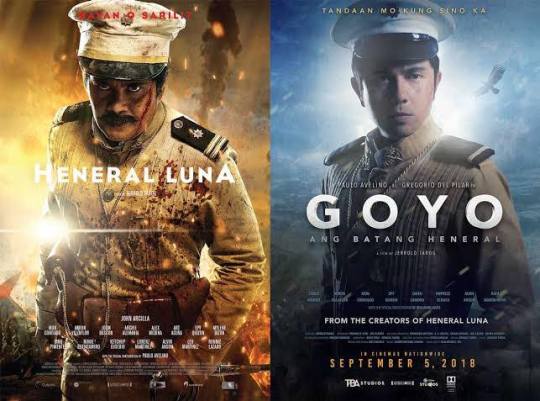
This blog is for the review of the movies: Heneral Luna and Goyo: Ang Batang Heneral. In which, both are masterpieces by Mr. Jerrold Tarog—he is the director of both films and many other films for the Filipinos, which then the masses loved.
The cast of both movies–John Arcilla as Antonio “Heneral Luna” Luna, Paulo Avelino as Gregorio “Goyong/Ang Agila” H. Del Pilar, Mon Confiado as Emilio “Miong” Aguinaldo, Arron Villaflor as Joven Hernando (fictional character for both movies), and Jeffrey Quizon as Apolinario “Ang Utak ng Rebolusyon” Mabini; these characters played significant roles in both films and sparked the revolution for the Filipinos way back after the Three hundred and thirty-three (333) years of Spanish Colonization.
The movie has struck my mind wherein my high hopes were met, especially on Heneral Luna. Its veteran cast and story caught my attention, for I am not a bookworm who spends hours of learning through books. I prefer gaining knowledge through watching clips and listening podcasts, mainly Philippine history. These platforms can give the viewers or listeners a full depiction of what happened in the past rather than text in a book.
Both films are in-line with each other as Heneral Luna's movie took a break first and followed by Goyo: Ang Batang Heneral. The plot of the motion picture for Heneral Luna—the Spanish colonization ended after three hundred and thirty-three (333) grueling years of cruelty, death without exile, rape among women, and no regard for respect for our own country. The Spanish parliament took place in the government. After colonization, Spaniards did not want to surrender to the Filipinos, but instead, they had sold the Philippines to the Americans for twenty million dollars ($20,000,000).
The Filipinos and its parting government unknowingly have issues about their president of that time, who was Emilio Aguinaldo. He became biased on whom to protect and a cowardly reckless leader. The movie showed that the officials were having arguments in meetings and were undecided if they should let the Americans enter. Besides, perceiving if they should let them take place in our government. Felipe Buencamino and Pedro Paterno were some of the Filipino Ilustrados. (in the Spanish era, they were the enlightened or the educated ones; included in the Ilustrados is the Hero of the Philippines, Dr. Jose Rizal) argued that the Americans are here to protectorate the Philippines, and us.
Buencamino and Paterno told the cabinet that Filipinos should look at Americans as allies. However, this argument made Luna and his co-leader Jose Alejandrino, the military leaders for the said meeting, had an outrage. They argued back that it was for the betterment of the country to continue its independence and the revolution. Also, not to waste what our predecessors fought for–to gain independence. At the end of the meeting, one of the guards told the President and Apolinario Mabini that the Americans had already stepped foot. General Luna asked the cabinet to authorize the strike upon the Americans, as early as they can, before letting them have the advantage of more troops than ours.
Mabini warned the cabinet that there were other 7,000 ground troops for the Americans that were on their way in the Philippines. Both generals wanted to strike immediately, wished the soldiers to be ready and to sacrifice for the combat. President Aguinaldo sent Buencamino and Arguelles to handle the debate. He assured the cabinet that Americans would keep peace and order to fight and win against the Spaniards.
On the 13th of August, in the year 1898, the Spanish and American generals discreetly planned a land engagement to turn over control of Intramuros. The incident dragged a new war for General Luna and the Philippines. Buencamino and Paterno showed support for the protection of the United States to the Philippines, which meant that the Philippines would be under the sovereign of the United States of America. Being enraged by their actions, Antonio Luna had a requisition of the traitors (Buencamino and Paterno) of the constitution they swore to support it.
Next, Luna inquired for his resignation as the general, knowing that the traitors were free. Aguinaldo declined the file of the departure of Antonio Luna as he saw him as the only one who was capable of winning the fight. Aguinaldo had approved the General’s appeal on moving the Philippine military headquarters up north.
Later, Luna received a letter from the president, stating that the president paged him in his headquarters in Cabanatuan. Although suspicious, he went to Cabanatuan with pride and honor on his shoulders, having Roman and Rusca upon him. Arriving at Cabanatuan, most of the streets were empty, and the soldiers already left in the morning. Few soldiers remained, mostly from the battalion of Kawit. As Luna went up to the office of the President, he saw only senator Buencamino relaxingly sitting on the President’s chair. While anticipating the general’s arrival, they exchanged heated words with one another. Then, a single shot’s sound reached the office. Upon Antonio Luna’s investigation, he encountered Captain Janolino, who he jailed him up, weeks after the start of the commotion between the American soldiers and Philippine battalion. Wherein, Captain Janolino did not follow the General’s orders. These men from the Kawit battalion shot, stabbed and hacked General Antonio Luna to death. On the other hand, Roman died as well, while Rusca had surrendered to the Kawit soldiers.
At the end of the Heneral Luna movie, it said that the Philippines blamed Aguinaldo for Antonio Luna’s death. However, Aguinaldo denied and gave the general an excellent reputation for him and calls him the most brilliant and capable general. On the other hand, at the same table that the president sat were MacArthur and Otis, who were giving Luna an acknowledgment as a worthy antagonist. They laughed at the Filipinos that they killed the only real general they had.
After that, the President’s favorite–General Gregorio del Pilar or better known as Goyong/Goyo is the next in line to the late, General Antonio Luna, to the sequel movie entitled as Goyo: Ang Batang Heneral.
The movie started in a phase, where the new General had so many rumors about his love life. Through all provinces that he and his men and went to, there would be women that found his handsomeness intriguing. Additionally, there would be a lady that would get in a relationship within every province. If not, he would court to make the lady fall in love, but does not have the intention to have a relationship.
After, General Antonio Luna’s death the next five months had been quiet for the Filipino soldiers—they became relaxed, having a thought of the American’s had stopped the war—afterward, Goyong and his men had captured Manuel Bernal and his little brother, who was included in General Luna’s men, and they are brutally asking him that he should join the force and help on the revolution against the American’s.
Meanwhile, Joven Hernando—now works for his uncle who is Goyong’s assigned photographer; on the other hand, whilst the Filipino army are laid-back, because of the silence of the combat between two forces—the allied forces from the American’s are formulating the second attack Luna’s comrade, Jose Alejandrino, who is saved from the extermination, now meets Apolinario Mabini—who had resigned from President Aguinaldo’s administration afterward the death of Antonio Luna. Pule, then plead Jose Alejandrino to identify the true source of Luna’s annihilation. In addition, Emilio Aguinaldo adjoined General del Pilar at Bulacan—to promote him as the Major-General of Pangasinan, at this time Goyong is beginning to address his love for Remedios—who is the daughter of Don Mariano that has the reputation of being elusive among all to the man who tried to court her. In the next scene, the President met Apolinario to offer him to be the Chief of Justice, in which Pule hesitantly accepts.
General Alejandrino then arrives at Manila to have a negotiation with General Arthur MacArthur Jr. and General Elwell Otis, who had rejected the Filipino General’s request to have peace and order; later then, the animosity continues, and still the Filipinos are off-guard. Aguinaldo then mandated the army to move to Pozorrubio, Pangasinan to have a bigger and stronger army against the surging American soldiers to claim the Philippines at the same time meet General Manuel Tinio for his soldiers to join fellow men on war. Yet, with the President’s request, Tinio and his company had been defeated by the Americans and caused Emilio Aguinaldo to push further north with his family and the army to retreat. The backbreaking march that escorts the President and his family through the mountainous region of Cordillera, the growing tensions between the Kawit soldiers and the late General Luna’s army, the day-to-day intrusion by the American soldiers had made the Army’s defenses fail, to which the mother and the son of Aguinaldo had been captured.
When the squad had reached Mount Tirad in Ilocos Sur, the Major-General had devised a plan to delay the Americans on capturing the President. Collectively with the former sharpshooter of Antonio Luna—Lieutenant Garcia, had reinforced the trenches that were dug along the direction of the mountain. The succeeding day, the American infantry had reached the town at the foot of the mountain, however they cannot infiltrate through the defenses placed by the Philippine soldiers; but through their native guide, the soldiers from America that are under Major Peyton March, had found a path that leads to the top of the mountain, without letting the Filipino soldiers know that they are coming; with this path the Filipinos are then overruled by the American soldiers. The Filipino Major-General then went to the far side of the mountain where he could see the beauty of the mountains, where he resolved to finish the fight against the Americans and surrender, nevertheless he was shot by an American sniper and died. To this result, the spirit of the Philippine allies had broken down and surrendered, while the President fled. Joven and Kiko—Lieutenant Garcia’s son, fled as well, but Joven fell to a cliff in an encounter with an American soldier.
The Americans then had captured the President on 23rd of March, 1901, which basically ended the war. Apolinario Mabini was then captured and was exiled to Guam, where he had written a narrative of his, named “La Revolucion Filipina”—through his writings, he appointed the former President, Emilio Aguinaldo’s failure as an effective leader of the Philippines. Then Remedios received a letter from Goyo.
First and foremost, I liked the star-studded cast of both movies—in which, it is shown that the directors and the writers had thought and planned both movies very well; the plot and the setting of the movies are organized as well, the movie techniques are on point, and it is as if that the viewers are into the place and the chosen kinds of music for both movies are nicely thought of—especially on Goyo: Ang Batang Heneral’s movie, where the “Millenials” are aware of the music from Ben and Ben Band, lastly the I loved how they depicted the movie inlined with the Philippine history to let the generation today learn on how Filipinos had fought against the Americans and the antiquity for how we are today.
I did not like that there are parts that are incomplete if it is compared to the written stories from the past, as well as, there are screen times on how they depicted wrongly about the past.
“May mas malaki tayong kalaban sa mga Amerikano—ang ating mga sarili”, by General Antonio Luna, these words had struck me for they had not seen the truth that the Filipinos are in deep problem with their administration to which had the Filipinos sacrificed their own lives, only knowing that they have a cruel and mindless government; “Walang naka-aangat sa batas—kahit pa ang Presidente”, the words from General Luna proves that the President has an ineffective way on ruling and running the Philippine government; from Joven Hernando—”Ano ba ang halaga ng isang bayani? Bakit tayo pirming naka tingala at sumasamba anng walang pag dududa?”, he implied that the Filipinos in a way are a bunch of children that give full credits to the heroes of war and not thinking if they had done something wrong for us; “Pag bumagsak si Aguinaldo, may bagong titindig. Pero ito—hindi ito mapapalitan.”, even though we are fighting against our own race, we should not leave the lands we own of, we should take care of themand keep them untouched; “Bumigo ang rebolusyon dahil mali ang pamumuno nito”, it shows how the cabinet of the President is unwell and there are a ton of misconceptions on how they are ruling the Philippine government and that is basically why we lost the revolution to the Americans.
In conclusion, no matter what and how the past is depicting us as Filipinos, we should not fully embrace it and live a new life, nevertheless, it should not give us the idea of forgetting the past and how our ancestors have fought for our freedom and lands.

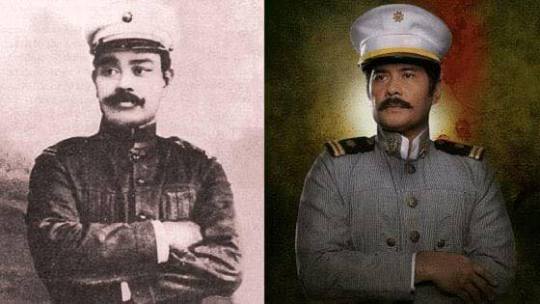


Sources
Netflix
https://www.pinterest.ph/pin/574983077404647285/?lp=true
https://www.spot.ph/entertainment/movies-music-tv/63720/10-quotable-quotes-heneral-luna
https://medium.com/@letzky/takeaways-on-goyo-ang-batang-heneral-6d12014d2341
https://www.wheninmanila.com/goyo-ang-batang-heneral-which-scenes-are-fact-or-fiction/
https://filipiknow.net/facts-about-heneral-luna-movie/
2 notes
·
View notes
Photo

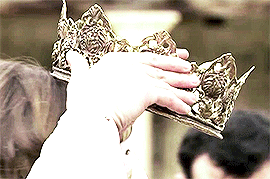


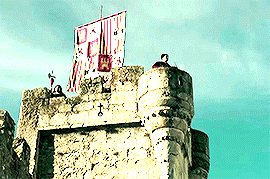

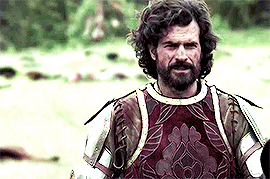

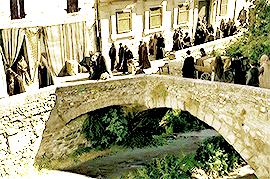

In the years 1480-1490 occurred a generational shift in the reigning dynasties of Europe, immersed in capitalizing, under their leadership, on social, political, economic and even religious movements that favoured the major cohesion and integration of their kingdoms. In France it would be Louis XI Valois (1461-1483); in England it would be Henry VII Tudor (1485-1509), and in Scotland James IV Stuart (1488-1513); in Spain the same function would be carried out by the Trastámara dynasty, after the wedding of Isabella I of Castile (1474-1504) and Ferdinand II of Aragon (1479-1516).
These national European dynasties were firmly established towards the last quarter of the 15th century, the majority of them ruled with continuity during the following century: in the case of the Valois those were 128 years (from Louis XI to Henry III), in the case of the Stuarts 137 years (from James IV to James VI) and in the case of the Tudors 118 years (from Henry VII to Elizabeth I), when they exercised power uninterruptedly until the end of the 1500s, the Portuguese kings of the house of Avís did so for 85 years (from Manuel I to Henry I), whereas the dynastic union of the Trastámaras from Castile and Aragon was rather fleeting, for it lasted only 37 years (from Ferdinand II’s accession to the Aragonese throne until his death), given that at the beginning of historical modernity, both kingdoms were absorbed by an European dynasty of ancient ancestry, the Habsburgs, with imperial vocation and aspirations to become universal monarchy, that in 1516 managed to include the two Hispanic kingdoms in their zone of influence.
Nevertheless, in European historiography it’s emphasised that Spain was the example of precocious maturity in regards to the national formation as a modern State, ahead of almost a century, compared to any other nation and State of western Europe. It’s argued that the “national union” achieved with the marriage of the Catholic Kings, both of them members of the Trastámara dynasty, would have been an act of historical advance and example of modernity: Isabella as singular model of queen, Ferdinand - as sagacious politician.
Opinion of Antonio-Miguel Bernal, expressed in “Fernando el Católico, rey”
#perioddramaedit#historyedit#isabel tve#isabella i of castile#ferdinand ii of aragon#spanish history
147 notes
·
View notes
Text

In 2015, a historical biopic film titled “Heneral Luna” was premiered in cinemas in the Philippines. It the first movie of the Artikulo Uno trilogy, all three films will be directed by Jarrold Tarog. The movie was centered on the life of General Antonio Luna, one of the country’s fiercest generals of his time, and his life leading up to his death. It was a critically acclaimed film. People gave high praises for the film’s acting, plot, writing and cinematography. The film showcased not only the Philippine’s history but also the talent we have in the field of film and cinematography.
Now in 2018, the second movie, “Goyo: Ang Batang Heneral” was premiered for the Filipinos to enjoy. It was centered on the life of General Gregorio Del Pilar and how he lead the unsuccessful fight in Mount Tirad, commonly know as “Labanan sa Tirad Pass”.
Me and my friends were actually very excited for this film since we were fans of the first film of this trilogy. Not only did the film contain important information about our history, but it also entertained us with the different antics our forefathers got themselves into. But, “Goyo” was different.
Don’t get me wrong, I’m not saying it was a bad film. The film still excelled in acting and cinematography. What made it different was the mood. it felt more serious, eerie even. It delved more on the hardships our soldiers went through in the second world war. It wasn’t a movie that made you laugh but crushed your heart in the end, like Heneral Luna. It was a movie that exhausts you emotionally, will piss you off, will make you fall in love and break your heart

To start off, I give high praises to the people involved with the cinematography, I was amazed with how well they shot everything. The shots from Mt. Tirad really stood out. It gave you the urge to go and explore the country more, see places like Mt. Balagbag, where they shot the scene in Mt. Tirad.
The costumes in this movie are no joke. A big part in historical movies like this are the costumes, it really sets the tone of the whole film, makes it look believable and realistic. I really loved how beautiful the national outfits were, especially the baro’t saya worn by the ladies. I also liked how Remedios stood out from all the other females in the movie, which really made you feel like you’re Goyo himself. You can understand why he was so captivated by her in the first place.
The movie focused on so many topics but the main topics that stood out to me was the toxicity of idolization, questioning what you are fighting for, the true meaning of love and bad leadership.
One of the scenes that really gave me chills was the when they were encouraging Maj. Manuel Bernal to join the revolution. Not only did actor, Art Acuña, give arguably the best performance in the entire movie but he also opened the topic of idolization and the toxicity it brings. This lead to the other main topic of the movie. Goyo, played by Paulo Avelino, was very young for a major general. He was only 23 when he was named major general of Pangasinan. In his age, he was still trying to find himself, still trying to figure out his purpose and what he’s fighting for. That’s what Goyo struggled with throughout the movie, his identity and death. The was he died was foreshadowed throughout the film yet the way he died still shocked the audience. Kudos to Tarog for that.
The love story between Remedios and Goyo really captivated a lot of the audience. It was a very typical movie-like setting, the playboy was changed by one extraordinary girl. Yet, something about this setting in that time period was interesting. This also drove the story, it gave Goyo another reason to keep on fighting, to get home alive to his one true love. Yet, their story didn’t end in a happy ending because of Goyo’s death. His love for Remedios was not enough for him to abandon his duties as a general. Something that’s both sad and admirable.
The monologue by Mabini really captured the topic of bad leadership. The way Emilio Aguinaldo led our country was not the best. He obviously had no clue how to fight the Americans. He made decisions that killed a lot of people, including one of his best generals, Antonio Luna. It made me feel like we never really had a chance with leaders like him. He wanted peace without freedom and that’s what we got.
As the movie was filled to the brim with symbolism, I liked how Joven was used as a way to intertwine the two movies in the trilogy. As the reoccurring character and the narrator of the films, you can really feel like the they’re all in one story line, regardless of how long it was till the next movie was premiered.
Joven’s symbolism for the youth also struck me. His name literally translates to “youth” in Spanish. He was the perfect example of the youth of this country. He wanted righteousness to prevail, still naive with what’s happening in the real world. But, what I love about this is how the movie implied that Goyo was also like Joven, still young and lacks wisdom, not ready to face the real world.
Lastly, I really appreciate the way our heroes were portrayed in this film. They brought them down from their pedestals and made them human. You saw how flawed they were despite how highly textbooks portray them. The movie is a great reminder that even our heroes were humans too, they also made mistakes. Mistakes that not only affected their lives but also the lives of us Filipinos.
Overall, the film might have been slow paced, might have been different from my expectations, but it was a good film nonetheless. It gave a different feel, a different vibe, a different way to tell a story that built this country. It was different in a good way. I really encourage more people to watch this film and the first film form the Artikulo Uno trilogy. This made me very excited for the third movie, made me excited to see witness, through film, a part of our history and who we are.
2 notes
·
View notes
Text
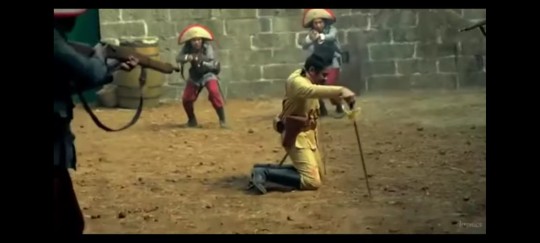
Title : HENERAL LUNA
Movie Summary
Spain's 333 years of Philippines colonization ends in 1898. Unwilling to surrender to the Filipinos, Spain sells the archipelago for $20 million.
While the Americans prepare to claim their latest colony, the Filipinos argue amongst themselves, unaware of their country's fate under the Treaty of Paris.
December 1898. In Bulacan, particularly in the Barasoain Church that serves as their hideout, President of the First Philippine Republic, Emilio Aguinaldo , his Prime Minister Apolinario Mabini and his presidential cabinet are debating the issue of the American presence in the Philippines.
Filipino ilustrados Felipe Buencamino and Pedro Paterno argue for an American alliance with Philippines as its protectorate. This angers the military leaders present in the cabinet meeting: General Antonio Luna and General José Alejandrino who want to continue the revolution for Philippines independence. They are wary of the presence of American forces in the country, believing another imperialist nation will simply replace the Spaniards. They are concerned about the latest American orders barring Filipino troops out of the walled city of Intramuros since the mock Battle of Manila in August. Intramuros is the seat of government and power base of the Spaniards in the archipelago.
Luna's military instinct senses something afoot. He asks the Cabinet to authorize a pre-emptive strike against their liberators to take control of Intramuros while the Americans forces have not yet landed their ground troops and the Philippine Revolutionary Army still have the advantage.
Prime Minister Mabini specifically warns the cabinet of the 7,000 additional American reinforcement arriving to fight any insurgencies. The Generals want to strike now, reiterating their soldiers' willingness to sacrifice their lives for their country.
Aguinaldo is swayed by the elitist voices in the cabinet and leans towards continuing American peace and trade discussions and sends Buencamino and Arguelles to meet with them. He assures his cabinet that the Americans promise to help win freedom from their Spanish overlords.
The truth was that months earlier on August 13, 1898, local Spanish and American generals, secretly and jointly planned a land engagement, later known as the Battle of Manila"[12] to transfer control of Intramuros from the Spaniards to the Americans.
Following the surrender of the Spaniards, the Americans turn their attention to keeping General Aguinaldo's men out of Intramuros, an unusual order questioned by the Filipinos who provide support for the Americans. Filipino forces were not able to capture Manila, increasing anti-American sentiments and suspicions that the liberators are our next conquerors.
As it turns out, the peace talks come up empty-handed for the Filipinos. On December 10, 1898, Spain and United States of America sign the Treaty of Paris that ends the Spanish American war. Spain cedes authority of the Philippines to the United States. They turn over Intramuros to the Americans, while American troops begin to engage with Filipino soldiers and seize control of cities like Santa Mesa, San Juan, Paco and Pandacan, showing aggression against any Filipinos resistance. After their fight against the Spaniards, the Filipinos fight another war.
Luna and his trusted comrades – General José Alejandrino, Colonel Francisco “Paco” Román , Captain Eduardo Rusca , Captain José Bernal and Major Manuel Bernal – embark on an arduous campaign against the invading American forces. During an intense battle against American troops led by General Arthur MacArthur Jr. and General Elwell Otis ., Luna asks for reinforcements from the Kawit Battalion but its commander, Captain Pedro Janolino , refuses to comply because the order did not come from President Aguinaldo himself. Luna angrily rides to Janolino's camp, humiliates him in front his men, and dismisses the battalion for insubordination. Luna then assembles an army of 4,000 soldiers by declaring his infamous "Article One", stating that all who refuse to follow his orders shall be executed without the benefit of a trial in a military court. He also recruits Lieutenant García after witnessing his marksmanship skills, and makes him commander of his elite unit of snipers and sharpshooters.
As the new war drags on, Buencamino and Paterno indicate their support of a proposal for Philippine autonomy as the protectorate of the United States. Enraged by this, Luna orders their arrest as traitors to the constitution they swore to uphold. Aguinaldo reluctantly arrests them, especially as Prime Minister Mabini validates Luna has grounds.
Luna's military campaign is undermined by General Tomás Mascardo , who opposes Luna's order for reinforcements, stating that he will only follow the President's direct orders. While the two generals are about to clash in Pampanga, the Americans advance steadily as other Filipino generals like Gregorio del Pilar retreat to the north. Luna visits Aguinaldo and Mabini to file his resignation, knowing that Buencamino and Paterno have been set free. Aguinaldo refuses to accept his resignation, and approves Luna's request to establish the Philippines Military headquarters in the north.
Later, Luna is summoned to the President's headquarters in Cabanatuan. Although his officers are suspicious of the telegram, Luna rides to Cabanatuan, bringing only Román and Rusca with him. Upon arrival, the streets are unusually empty, most of the soldiers had already left the president's headquarters under Aguinaldo's orders, with the exception of some elements of the Kawit Battalion and presidential guards. Luna discovers that Aguinaldo had already left that morning, and only Senator Buencamino remains in the office. As they exchange heated words, a single shot is fired outside. Luna investigates and encounters Captain Janolino and his men, who attack him. Luna is shot, stabbed, and hacked repeatedly to death. Román is also killed while a wounded Rusca surrenders to the Kawit soldiers. Most of Luna's remaining loyal officers are arrested during the purge, while some are tortured and killed, including the Bernal brothers, Heneral Luna's closest aides.
As ordered by Aguinaldo, Luna and Román are buried with full military honors by the Kawit Battalion - the same men who killed them. Mabini, who is among the mourners, notices a bloodied Machete on one of the soldiers; however, the inquest exonerates the Kawit Battalion and Luna's killers are never caught.
After the war, while American newspapers in the Philippines quickly blame Aguinaldo for Luna's death, Aguinaldo denies his involvement on the assassination; calling Antonio Luna as his most brilliant and most capable general. MacArthur and Otis acknowledge Luna as a worthy adversary, laughing at the fact that the Filipinos killed the only real general they had.
In the film's post-credits scene at the end, General Gregorio del Pilar prepares to cover President Aguinaldo's retreat to the north. Del Pilar inspects Luna's remaining men and orders his aide, Colonel Vicente Enríquez to select 60 of them
Guide Questions
1.What life lessons can be learned from the movie?
Being brave and being positive thinker to look forward in your success just like the traits of heneral luna.
2.What part of the story told by the movie was the most powerful? Why?
When his death didn't have justice. And the betrayal of his own fellow filipino. Beacuse the feeling of being betrayed by your countrymen hurts more than the gunshots and blades that dug into his body.
3.Who was your favorite character in the movie? Why?
heneral luna because he did everything to protect his beloved country and continue the revolution for philippine independence through the hands of americans eventhough he had to fight with his own countrymen.
4. Did anything that happen to the movie remind you of something that has occured in your own life or that have seen occur to others?
I also experience betrayal. Even my own friends betrayed me.
1 note
·
View note
Text
The Weekend Warrior Home & Drive-In Edition June 19, 2020 – YOU SHOULD HAVE LEFT, BABYTEETH, MISS JUNETEENTH, 7500 and More
We’re three weekends into June and New York City is still in Phase 1 of reopening (movie theaters will presumably be in Phase 4), but I’m already hearing that movie theaters will continue to reopen over the next few weeks with New York and L.A. finally opening on July 17, which is when we’re supposed to get some new theatrical releases. We’ll see if that happens or not.

In any other week, the Blumhouse psychological thriller YOU SHOULD HAVE LEFT (Universal), which reunites Stir of Echoes director David Koepp with that film’s star, Kevin Bacon, would be getting some sort of theatrical release, probably in 2,500 theaters or maybe more. Instead, it’s going to the same PVOD platform used by Universal for Trolls World Tour and last week’s The King of Staten Island, which is kind of shame. Not that I can say whether I liked the movie or not since I’m under embargo, but I can at least say what the movie is about, kinda.
Bacon and his significantly younger actress wife, played by significantly younger actor Amanda Seyfried, move into a house in Wales with their young daughter Ella (Avery Essex), and then all sorts of strange things start happening… and that’s probably all I can say about the plot without spoiling stuff, although I will say that if you like high concept mind fuck movies, as I generally do, this is a doozy! [I’ll add my mini-review for this here once the embargo breaks on Thursday morning, and also I’ll have an interview with writer/director David Koepp over at VitalThrills.com around the same time.)
Mini-Review: When you come into a movie like You Should Have Left after having seen David Koepp’s previous movie Stir of Echoes with Kevin Bacon, you might imagine that would have been a tough act to follow. In fact, Stir of Echoes, while it still has some cool ideas, hasn’t aged particularly well, especially when you realize that it opened just a month after M. Night Shyamalan’s The Sixth Sense. As it were, You Should Have Left has a few similarities beyond Mr. Bacon, but it’s also a very different movie that benefits from fitting into the mold of some of the better recent Blumhouse movies.
In this one, Bacon plays Theo Conroy, a man with a troubled past an an extremely attractive and significantly younger wife, aptly played by Amanda Seyfried. There are already problems in their marriage when we meet them, but soon afterwards, they’re renting a house in a remote part of Wales in order to get away with their young daughter (Avery Essex). Conroy is still being haunted by the death of his previous wife, for which he was blamed but this new abode starts giving him horrifying nightmares as well as odd circumstances with the house having all sorts of nooks and crannies that should not be geographically possible. (I’m trying to be vague as possible with the plot since there are definitely some nice plot twists and definite spoilers.)
It’s a fairly simple set-up as we watch things get worse and worse for Theo as he discovers that his wife has been cheating, and the house starts getting more threatening with Theo worrying even more about his daughter. But this isn’t a cheesy horror movie like House, and maybe at times, it couldn’t even really be thought of as quote-unquote “horror,” because it isn’t particularly scary until the third act when it does start getting VERY scary.
Of course, Bacon’s performance is going to be something eyed carefully to see how he’s grown as an actor in the 21 years since Stir of Echoes, and he certainly has, but it’s often his youngest co-star, Avery Essex, who not only steals the scenes but also pushes him to even greater heights with her own ability to keep things grounded and real even when things start getting crazier.
You Should Have Left is another fine Koepp chiller that frequently leaves you guessing about what is happening with its suitably claustrophobic mind-fuck esthetics and another well-nuanced performance by Bacon. It’s eerie and disturbing but also has an epilogue that somehow comes across as surprisingly sweet and even somewhat sentimental.
Rating: 7/10

Fresh from its much-lauded premiere at Sundance comes Shannon Murphy’s directorial debut, the quirky Aussie comedy BABYTEETH (IFC Films), which stars newcomer Eliza Scanlen as Milla Finlay, a teen girl with a disease that’s killing her, who falls for a drug dealer named Moses (Toby Wallace). Ben Mendelsohn and Essie Davis from The Babadook plays Milla’s disapproving parents, lecherous psychiatrist Henry and manic-depressive Anna.
Apparently, Murphy’s movie is based on a play written by Rita Kalnejai, which played a sold-out run in Sydney back in 2012, and while there are elements that make it seem obvious it’s based on a play, what Murphy has done with the material takes it far beyond its source material. I especially enjoyed the way it deals with young first love in a fairly sweet way but also in a very realistic way.
At first, Babyteeth is a little strange, maybe not quite on the level of strange of some of Miranda July’s work or the movie Lemon (which I hated) in that it’s actually watchable, but more like Taika Waititi’s Hunt for the Wilderpeople. Incidentally, all of those films premiered at Sundance just to give you some sense of the programming there, but it also reminds me more positively of Me and Earl and the Dying Girl, which not only premiered at Sundance but won both the Jury and Audience Award that year, so yeah, Sundance is nothing if it’s not a little predicable.
Eliza Scanlen and Toby Wallace are both great, but it’s all the quirky characters surrounding them that makes you unsure where it’s all going, but don’t be fooled by the film’s earlier quirkiness, because it does go to a few rather dark and dramatic places. Again, I liked it in a similar way as I liked Earl, and it’s a really strong directorial debut with fantastic musical choices, and I’ll be really curious to see whether people discover it right away or it becomes a cult favorite over time.

Channing Godfrey People’s new indie drama MISS JUNETEENTH (Vertical), starring Nicole Beharie, is probably one of the more relevant releases of the weekend because Friday is the annual Juneteenth celebration. Beharie plays Turquoise Jones, a woman who won the town’s annual Miss Juneteenth pageant decades earlier who now has a teen daughter Kai (Alexis Chikaeze) entered in the pageant.
I will freely admit that a few weeks back, I had no idea what Juneteenth was or what it represented, although I kept seeing it listed in my ICal every June 19. Then I heard about this movie and shortly after, I saw it referenced in Ava DuVernay’s Selma on a recent rewatch, so I looked it up – thinking maybe it was more of a Southern thing, which it is – and sure enough, it’s the date when Texas abolished slavery in 1965. I’m so glad that was settled.
Okay, back to the movie. I definitely was interested in it since like Babyteeth, Miss Juneteenth debuted at Sundance, but as expected for a festival mainly attended by critics from New York and L.A., it didn’t get very much attention, so it was probably always going to get a VOD release.
It mainly follows how Beharie’s character comes to term with not achieving some of the greatness of past Miss Juneteenth winners and hoping her daughter will achieve more than she did by winning the pageant. Kai really isn’t too interested in achieving greatness in the way her mother wants, as she would rather be a dancer. (Since it’s implied that Turquoise spent many years making money by stripping, it would make sense she wouldn’t that for her daughter.)
I kind of wish the movie did more interesting things with the characters but People’s screenplay is decent but not great, and it’s elevated by the talented Ms. Beharie and others. The interesting thing about Miss Juneteenth is that not only did the movie grow on me as I watched it, but it also oddly really stuck with me after it was over, even though it’s more of an intimate personal story about one woman rather than a bigger exploration of the holiday itself.

Joseph Gordon-Levitt makes his return to the screen (just not the big one) in Patrick Vollrath’s action-thriller, 7500 (Amazon Prime), playing the co-pilot of a German plane that’s hijacked by terrorists. I wish there was more to say about it beyond that simple plot, but there really isn’t, and the majority of the film takes place in the cockpit as Gordon-Levitt’s Tobias Ellis watches other activities taking places on monitor screens.
I’ve always been a fan of Gordon-Levitt as an actor but this material generally seems below his talents, and his performance falters suitably while trying to make more of what’s a fairly dated and tired script. On top of that, it’s just brutal to watch at times, and that’s not necessarily a good thing, despite the film’s intent at being a thriller. (One plot decision pissed me off so much I almost stopped watching.)
Honestly, I’m not even sure why they called this movie 7500, since there was already a horror movie called Flight 7500 a few years back, and that isn’t even the number of the flight in the movie, so this whole thing left me rather puzzled, not only how and why it got made but why it couldn’t have been even just slightly better.
Netflix got the rights to Olivier Assayas’ latest, WASP NETWORK after it played a bunch of festivals last fall, including TIFF, Venice and the New York Film Festival, and the streamer will premiere the spy-thriller starting Friday. It reunites Assayas with his Carlos star Edgar Ramírez, who plays René González, a Cuban pilot who flees Cuba to defect to the United States, leaving his wife (Knives Out’s Ana de Armas) and daughter behind. Once in Florida, he joins a group of exiles called the Wasp Network, led by undercover operative Manuel Viramontez (Gael Garcia Bernal) and becomes part of a pro-Castro spy ring infiltrating Cuban-American terrorist groups. I wasn’t hugely interested in the subject matter when I tried watching it at the NY Film Festival, and part of that was maybe because like Carlos, it requires a lot of patience and concentration that I’m sure I didn’t have last October. I hope to have a chance to rewatch it this week, and if I get all the way through it, I’ll add some sort of actual review.
Ross Boyask’s action-thriller sequel I AM VENGEANCE: RETALIATON (Saban Films/Lionsgate), once again stars former WWE wrestler Stu Bennett aka “Wade Barrett” as ex special forces John Gold who goes for justice (and vengeance and retaliation, if that wasn’t clear from the title) against the man who betrayed his team on their final mission, Sean Teague, as played by Guy Ritchie regular, Vinnie Jones. Haven’t had a chance to watch this in time to write about it for the column, but I also never got to watch the previous I Am Vengeance, but hopefully I’ll have more time before its digital debut on Friday.
Another film opening in Virtual Cinema (which is definitely the “new normal” these days) is Yonatan Nir and Dani Menkin’s documentary PICTURE OF HIS LIFE about acclaimed underwater wildlife photographer Amos Nachoum and his greatest challenge to photograph a polar bear while swimming with one in open waters sans protection. Another movie I wasn’t able to get to before writing this column – noticing a trend there? -- but it certainly sounds interesting, especially if the cinematography is as good as I’m expecting from watching the trailer.
I will freely admit that I’ve been a bit hit or miss on the recent work of multi-Oscar-nominee Agnieszka Holland and her more recent work, and her new film MR. JONES (Samuel Goldwyn) is another drama set during WWII as with her previous film, In Darkness. Thus one is written by Andrea Chalupa and stars James Norton as Gareth Jones, an ambitious journalist who goes to Moscow looking for the truth behind Stalin’s Soviet propaganda machine that is trying to sway the Western World in its battle against Hitler. Apparently, this would later inspire George Orwell’s Animal Farm, but honestly, this subject didn’t really interesting me, and neither could the presence of decent actors like Peter Sarsgaard and Vanessa Kirby. Either way, it will be released on digital this Friday then On Demand on July 3.
I’ve heard good things but haven’t had a chance to see Theodore Collatos and Carolina Monnerat’s documentary, Queen of Lapa (Factory 25), which is about influential Brazilian transgender activist Luana Muniz, which won the Grand Jury Prize at the 31st edition of New Fest, New York’s LGBTQ Film Festival, as well as a selection of a number of other film festivals. Muniz was a cabaret performer, sex worker and activist who helped humanize Rio’s transgender sex workers.
Related to this, Netflix will also debut Sam Feder’s doc Disclosure this week, looking at the way trangender men and women have been depicted in film and on television with leading trans creatives and thinkers like Laverne Cox, Lilly Wachowski, Yance Ford and others being interviewed. I haven’t watched it yet but will check it out when it debuts this Friday.
Hong Sang Soo’s 2006 film Woman on the Beach (Grasshopper Films) is premiering as part of Film at Lincoln Center’s Virtual cinema, which is actually one of my favorite films by the director.
Downtown at the Film Forum’s Virtual Cinema, you can watch Matt Riddlehoover’s doc My Darling Vivian (The Film Collaborative) about the relationship between Vivian Liberto and one Johnny Cash, who had a three-year long-distance relationship while the classic country singer was stationed in Germany and got married when he returned and became a household name.
This week’s rep stuff being added to Film Forum’s Virtual Cinema include Robert Hamer’s original 1960 comedy, School of Scoundrels (Film Forum/ Virtual), starring Alastair Sim – part of the trilogy of Sim films which will be available for rental through Film Forum -- and Jean-Pierre Melville’s 1953 noir, When You Read This Letter…
Apple Plus will be debuting Bryce Dallas Howard’s documentary Dads (just in time for Father’s Day!), which looks at fatherhood through a number of well-known fathers including Will Smith and one Ron Howard.
Other films that I haven’t had as much time to look into include Mope (Quiver Distribution) and The Pollinators (1091).
This week begins two more annual festivals, both of them going virtually with the AFI Docs Film Festival (done in conjunction with NBC’s “Meet the Press”) running from June 17 through June 21 and the Lighthouse International Film Festival, based in New Jersey, which will run from June 16 to 20. The latter’s opening film is Rod Lurie’s military drama The Outpost, which I’ve been looking forward to seeing for quite some time, while the Centerpiece film is Summerland. This week’s Oxford Film Festival offerings include the narrative feature, The Killing of Kenneth Chamberlain, will debut on Sunday. Unfortunately, you’ll have to live in Mississippi, Tennessee or Alabama to see the The Rabbi Goes West, presented by the Jewish Federation of Oxford.
Next week, more movies not in nearly as many theaters as usual… including (finally!) My Spy!!!
By the way, if you read this week’s column and have bothered to read this far down, feel free to drop me some thoughts at Edward dot Douglas at Gmail dot Com or drop me a note or tweet on Twitter. I love hearing from readers … honest!
#TheWeekendWarrior#Movies#Reviews#YouShouldHaveLeft#VOD#Streaming#Babyteeth#MissJuneteenth#7500#WaspNetwork
0 notes
Text
Goyo 2018: Mga Karakter Sa Buhay ng Batang Heneral
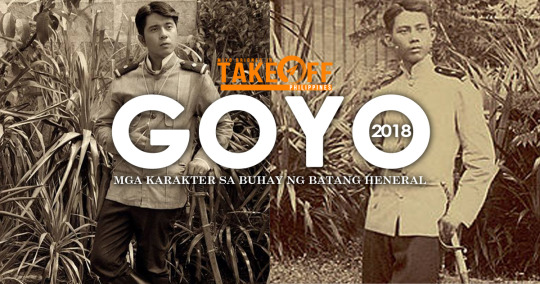
After the success of the first Filipino History Revolution Movie, “Heneral Luna” that was directed by Jerrold Tarog and give a big break to John Arcilla who played the Iconic Philippine General, Antonio Luna.
The story continues as this trilogy movie now revolves around the life of the boy general from Bulacan, Gregorio Hilario Del Pilar y Sempio. He was born on November 14, 1875, his family was a prominent Illustrado (Middle Class) back then. In his early years, he aided his uncle, Marcelo H. del Pilar, in distributing his anti-friar writings. He was a member of the revolutionary forces in Bulacan even when he was studying at the Ateneo de Municipal. When the revolution broke out on Aug 30, 1896, he joined the forces of Heneral Dimabunggo (Eusebio Roque).
He is most known for his successful assault on the Spanish barracks of Cazadores in the municipality of Paombong, his victory in the first phase Battle of Quingua.
He is known as the Hero of the Battle of Tirad Pass in Ilocos Sur which played by Paulo Avelino in the Movie, GOYO: Ang Batang Heneral. The movie is set to lit your inner soul and teach you a lesson from history that even the 4 corners of the classroom have not yet been discussed but before we watch this movie lets get to know the characters that will make and break our young hero, GOYO.
1.) Major Peyton March
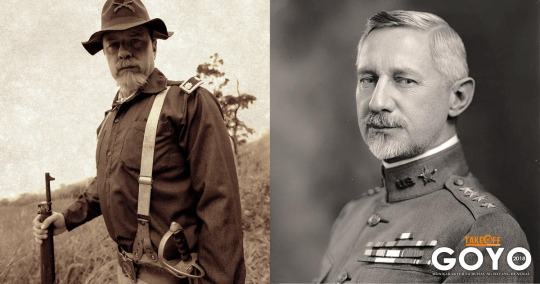
(Left) Jason Dewey portrays the role of Maj. Peyton March in GOYO 2018 Movie. Courtesy of GOYO: Ang Batang Heneral FB Page. (Right) Peyton March, Chief of Staff of the US Army in the 20th Century.
December 2, 1899
In the pursuant to delay the US Troops to get after President Aguinaldo’s Escape, Gregorio Del Pilar and 60 of his men formed a blocking force at Tirad Pass, Concepcion, Ilocos Sur Province. They constructed several sets of trenches and stone barricades, all of which dominated the narrow trail that zigzagged up towards the pass.
While Major Peyton Conway March led 300 soldiers of the 33rd Infantry Regiment of U.S. Volunteers, up the pass. Januario Galut, a Tingguian Igorot, led the American troops up a trail which they could emerge with the Filipino Troops. Del Pilar died in the battle, along with 52 subordinates. The Americans lost 2 men killed.
On Del Pilar’s diary, which Major March found, Del Pilar had written: "The General [ Aguinaldo ] has given me the pick of all the men that can be spared and ordered me to defend the Pass. I realize what a terrible task has been given me. And yet, I felt that this is the most glorious moment of my life. What I do is done for my beloved country. No sacrifice can be too great."
2.) Remedios Nable Jose
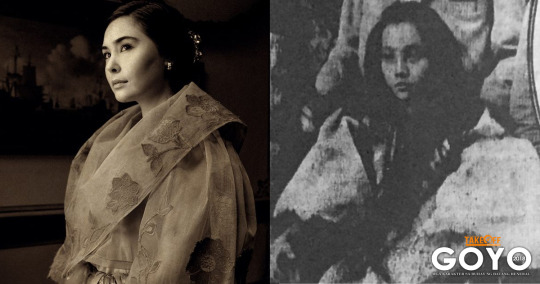
(Left) Gwen Zamora as Remedios Nable Jose in GOYO 2018 Movie. Courtesy of GOYO: Ang Batang Heneral FB Page. (Right) Remedios Nable Jose in the early 1890s, the last love of the boy general. Courtesy of GMA Network Lifestyle Section.
Dolores or Remedios Nable Jose was known as Goyo’s Last Love - As her name was found on a lady’s handkerchief embroidered when Americans looted the corpse of the Fallen General. Together with a diamond rings, gold watch, gold locket containing a woman’s hair.
3.) Felicidad Aguinaldo
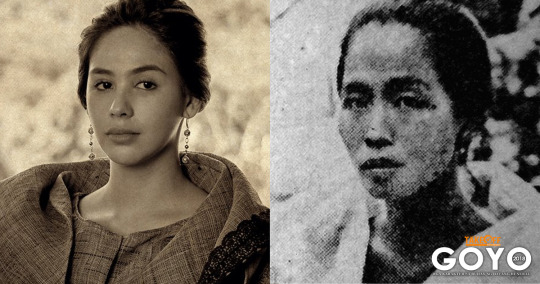
(Left) Empress Schuck as Felicidad Aguinaldo in GOYO 2018 Movie. Courtesy of GOYO: Ang Batang Heneral FB Page. (Right) Felicidad Aguinaldo, the younger sister of Emilio Aguinaldo.
There were numerous young women in history that was captivated by the Boy Genera, Goyo. One of which is Felicidad Aguinaldo. She reportedly knelt, prayed and wept at the exact spot where the young general died in Tirad Pass.
4.) General Arthur MacArthur
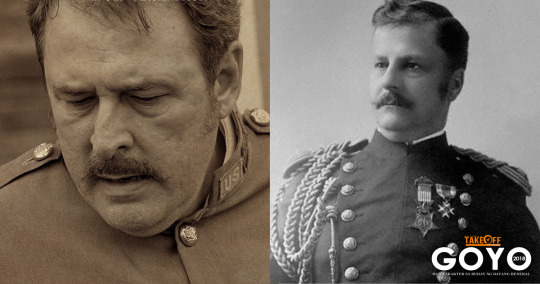
(Left) Miguel Faustmann as General Arthur MacArthur in GOYO 2018 Movie. Courtesy of GOYO: Ang Batang Heneral FB Page. (Right) General Arthur MacArthur, the military Governor-General of the American-occupied Philippines in 1900 but his term ended a year later due to clashes with the civilian governor, future President William Howard Taft.
He led the 2nd Division of Eighth Corps during the Philippine–American War at the Battle of Manila (1899), the Malolos campaign and the Northern Offensive.
The first important fighting of MacArthur's northward movement was at Quingua (now Plaridel), Bulacan Province, on April 23. It was a two-part battle.The first phase was a brief victory for the young Filipino general Gregorio del Pilar over the American Cavalry led by Major (later Maj. Gen.) James Franklin Bell, West Point class 1878, where Bell's advance was stopped.
5.) General Jose Alejandrino
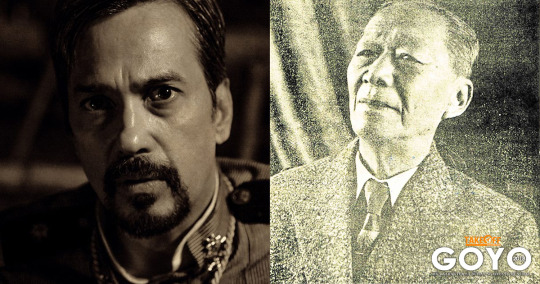
(Left) Alvin Anson as General Jose Alejandrino in GOYO 2018 Movie. Courtesy of GOYO: Ang Batang Heneral FB Page. (Right) General Jose Alejandrino, Courtesy of the Center for Kapangpangan Studies.
On June 4, 1899, Aguinaldo was in San Isidro, Nueva Ecija, heading to Angeles, when he employed del Pilar as the hatchetman, torturer. Aguinaldo was determined to liquidate Luna and his officers. Del Pilar was given the instruction of capturing Luna, dead or alive for Luna had been “accused of high treason.” When he got to Luna’s headquarters in Bayambang, only General Alejandrino, who scorned Del Pilar while receiving Del Pilar lying down in his bed, was there. He found out that Luna went to Cabanatuan, where Luna received his gruesome fate, which we witnessed being depicted by Heneral Luna in the cinemas, on June 5, 1899. He then turned his attention to the liquidation of the officers of Luna, most notably Capt. Jose Bernal, Maj. Manuel Bernal, Gen. Venancio Concepcion and Gen. Jose Alejandrino. Jose Bernal was assassinated in Angeles by troops of Col. Aquino. Manuel Bernal was tortured then summary-executed by Del Pilar’s henchmen. General Concepcion was relieved of command. General Alejandrino could have been killed by Del Pilar’s men, mistaking him as General Luna, but luckily saved by soon-to-be-General Urbano Lacuna’s clarification on Alejandrino’s identity. Aguinaldo also had plans to dispose Alejandrino, but knowing that the General’s brother, Joaquin, was part of the formidable Tinio brigade, which they were seeing as their savior, spared the latter’s life, assigning him to Mangatarem, La Union, then under General Lacuna in Mt. Arayat.
References:
https://en.wikipedia.org/wiki/Gregorio_del_Pilar
http://www.filipinoamericanwar.com/ilocosandcagayan1899.htm
http://www.gmanetwork.com/news/lifestyle/content/610067/ang-huling-pag-ibig-ni-gregorio-del-pilar/story/
http://www.filipiknow.net/facts-about-general-gregorio-del-pilar/
https://joshuaagar.wordpress.com/2015/09/23/was-gregorio-del-pilar-a-hero-after-all/
http://newsinfo.inquirer.net/789586/showing-the-human-side-of-heroes
For more Daily Dose Of Eyegasmic Occurrences follow our Social Media Accounts:
Facebook Fan Page: https://www.facebook.com/TakeOffPHBlog
Instagram/Twitter: @takeoff_ph
#goyo2018#paulo avelino#gregorio del pilar#history#takeoffph#takeoffphilippines#battle of tirad pass
14 notes
·
View notes
Text
"You're not a soldier, Goyo. You are a...dog."
— Major Manuel Bernal
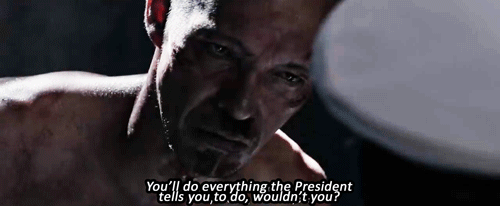
0 notes
Text
CARACAS, Venezuela | The Latest: Venezuelan soldiers on air to back Maduro
CARACAS, Venezuela | The Latest: Venezuelan soldiers on air to back Maduro
CARACAS, Venezuela—Jan 24, 2019— The Latest on the political crisis in Venezuela (all times local):
10:05 a.m.
Military commanders across Venezuela are taking to the airwaves to vow loyalty to embattled President Nicolas Maduro.
Major General Victor Palacio said Thursday he categorically rejected any acts threatening stability in Venezuela.
Opposition leader Juan Guaido a day earlier spoke to…
View On WordPress
#ap#associated press#back maduro caracas#Breaking News#Latest news#Local News#major general manuel gregorio bernal#major general victor palacio#military commanders#national news#news#profit venezuelan observatory#socialist president nicolas maduro#stl.news#TodayNews#us news#venezuelan soldiers#World News
0 notes
Text
The Real Story of Netflix’s Wasp Network – Who Were the Cuban Five?
https://ift.tt/eA8V8J
Wasp Network, written and directed by Olivier Assayas based on the book The Last Soldiers of the Cold War by Fernando Morais, has landed on Netflix. It stars Penélope Cruz, Edgar Ramírez, Gael García Bernal and Ana de Armas and is based on the true story of the ‘Cuban Five’ (aka Miami Five) who were arrested and imprisoned in the USA as spies in the late ‘90s. The five were Gerardo Hernández, Antonio Guerrero, Ramón Labañino, Fernando González, and René González, though Wasp Network focuses attention primarily on René González and Gerardo Hernández of the five.
They were Cubans who travelled from Cuba under Fidel Castro’s regime, to Florida and became part of a group called the Wasp Network (La Red Avispa) who infiltrated anti-Castro Cuban exile groups based in Miami so they could feed information back to the Cuban government. Hernández (played by Gael Garcia Bernal in Wasp Network) assumed the identity of Puerto Rican Manuel Viramontez and was sent over to lead La Red Avispa.
Some of these Cuban militia groups were organising terrorist attacks on Cuba, particularly focusing on tourist hotels in an attempt to destroy Cuba’s economy, as well as smuggling drugs to finance activity and smuggling weapons with a plan to assassinate Castro.
Though the Wasp Network claimed to have foiled many attacks, in 1997 several bombs were detonated in hotels in Havana. One in the Copacabana Hotel was the worst and killed an Italian businessman, injuring several others. The attacks were organised by militant exile and CIA agent Luis Posada Carriles (Tony Plana) and although he admitted to having masterminded the bombings, he was never charged.
One of the groups La Red Avispa infiltrated was called Brothers To The Rescue, a Cuban exile group whose stated main purpose was to help Cuban refugees escaping on rafts. Brothers To The Rescue was run by José Basulto (played by Leonardo Sbaraglia in Wasp Network), who recruited René González and Juan Pablo Roque (more on him later) as pilots. The group also distributed anti-Castro leaflets in Havana and was accused of plotting terrorist activities by Cuba.
In 1996 two Brothers To The Rescue planes were shot down by the Cuban government killing the four pilots who were US Citizens. After this incident the US government who had been covertly monitoring the Wasp Network began to crack down.
The Cuban Five were arrested in 1998 and when they were prosecuted on various charges including espionage, Hernández was also charged with conspiracy to murder, the logic being that the intelligence fed back to Cuba is what lead to the deaths of these men. Hernández however maintains that this isn’t even true. Hernández was sentenced to two life terms to be served consecutively, René González got 15 years, Guerrero and Labañino got life sentences and Fernando González got a 19 year sentence.
The scene where Juan Pablo Roque denounced Brothers To The Rescue on TV after he had unexpectedly returned to Havana happened in real life, too.
Who was Juan Pablo Roque?
He was a former Major in the Cuban air force who defected to Florida and became a pilot with Brothers To The Rescue. While in America he became an informant for the FBI and was also part of the Wasp Network. He married secretary Ana Margarita Martinez (Ana de Armas) but 11 months after their wedding he disappeared back to Havana without saying a word to her. She later sued the Cuban government and was awarded $27 million punitive damages but only collected $200,000.
What was the spy swap that saw the release of Gerardo Hernández?
In 2014 under Obama’s leadership it was agreed that three members of the Cuban Five – Gerardo Hernández, Antonio Guerrero and Ramón Labañino – would be released in exchange for the Cuban government releasing American citizen Alan Gross who was accused by Cuba of spying and imprisoned. The other two of the Cuban five had already been released – René González in 2011 and Fernando González earlier in 2014. The swap was very important for diplomatic relations between America and Cuba not least because in Cuba the Five are perceived as heroes who were not spying on America but only on militant Cuban exiles who were a terrorist threat to Cuba.
What happened to Olga Salanueva?
René’s wife Olga was deported after three months in prison. She reunited with her daughter and campaigned for the release of the Five. More recently, in Jan 2018, she was in the press for writing an open letter criticising the Cuban government for not choosing her husband René as a member of parliament when two of the Five were selected. Fernando González and Gerardo Hernández had been listed as candidates while René González, Ramón Labañino and Antonio Guerrero were not.
How about Gerardo Hernández’s wife?
In the movie Hernández’s wife Adriana Perez (Anel Perdomo) mentions wanting a child. It’s a nod to what happened in real life. While Hernández was still incarcerated, Perez was afraid her chances of having a child were running out. She made a personal plea to a US Senator visiting Cuba and in 2013 as a sort of humanitarian gesture, Hernández’s sperm was transported to Panama for a first attempt at artificial insemination. This didn’t take but a second attempt in 2014 was successful. This is how, in images of the two just after Hernández’s release Perez is visibly pregnant.
Who were the other three, of the Cuban Five?
Antonio Guerrero
Guerrero was born in Miami to Cuban parents but returned with them to Cuba when he was just a baby. He was a bright student who studied as an airfield construction engineer in the Ukraine and worked on the expansion of the Santiago de Cuba International Airport. Guerrero was assigned a mission to go to Miami for the Wasp Network. Guerrero got life plus ten years, later resentenced to 21 years and 10 months. He was released on December 17 2014. He writes poetry and has two kids.
Ramón Labañino
Labañino was born in Havana and was also a very bright student who studied economics at university and was a strong sportsman. He went to Miami to work for Red Avispa and was originally sentenced to life plus 18 years, which was adjusted to 30 years. He was also released in December 2014. He has three daughters.
Fernando González Llort
González Llort studied International Political Relations and after he graduated served in the Cuban Revolutionary Armed Forces in Angola. He moved to Miami in 1993 to join Red Avispa and when he was arrested was sentenced to 19 years, later adjusted to 17 years and 9 months. He was released on February 27 2014. After his release he became a member of Cuba’s parliament and still works as a politician and a diplomat.
Wasp Network is available to stream on Netflix now.
The post The Real Story of Netflix’s Wasp Network – Who Were the Cuban Five? appeared first on Den of Geek.
from Den of Geek https://ift.tt/2CYpACB
0 notes
Text
Goyo: Ang Batang Heneral Summary
General Gregorio Del Pilar is one of the youngest General in the Philippine army. He gain his position because of his courage and a patriot. But the movie Goyo focuses on General Del Pilar's private life and how he spend his days in uneasy peace. He's spending his time in relishing his quick promotion by flirting girls and other personal things. Even though General Gregorio Del Pilar had a rough past, he is known as the hero of the Tirad Pass. The young General Gregorio Del Pilar is describe as a passive creature who is gullible to the adoration of his comrades and fans. General Gregorio Del Pilar has a deep relationship with the President Emilio Aguinaldo, not only because he is the favorite but the President knows that General Gregorio Del Pilar is loyal and respects him. But the movie portrays the blindness of General Gregorio Del Pilar in terms of his loyalty. When General Gregorio Del Pilar captured Manuel Bernal a loyal soldier of General Antonio Luna, said to the young General that his principle and loyalty are wrong. Manuel Bernal make General Gregorio Del Pilar realize that he is blind in loyalty to the President Emilio Aguinaldo. When the Americans invaded the Philippines, General Antonio Luna led the army of the Philippines and has the principle to make our country free. The blindness of loyalty, corruption in government are the major problems that made the Philippines defeated. Some are wiling to sacrifice their life for rhe country but majority of Filipino’s still don’t have the courage to claim our freedom. The main focus of the movie is all about the honor, duty, and sacrifice of The young General Gregorio Del Pilar.
0 notes
Text
GOYO


Philippine history will have another live re-imagining with Jerrold Tarog’s “Goyo: Ang Batang Heneral.” “Goyo” is the sequel to the historical biopic “Heneral Luna.” Both are directed by Jerrold Tarog. Gregorio del Pilar, nicknamed “Goyo,” was one of the youngest generals during the Philippine Revolution and the Philippine-American War. He was a loyal protege of Emilio Aguinaldo. To promote the movie, characters portraits were revealed with a dated 19th-century look. Paulo Avelino plays the young general; his boyish good looks have earned him the title “Baeyani.”
Reprising their roles as historical figures are Mon Confiado (Pres. Emilio Aguinaldo), Epy Quizon (Apolinario Mabini), and Benjamin Alves (Manuel L. Quezon).
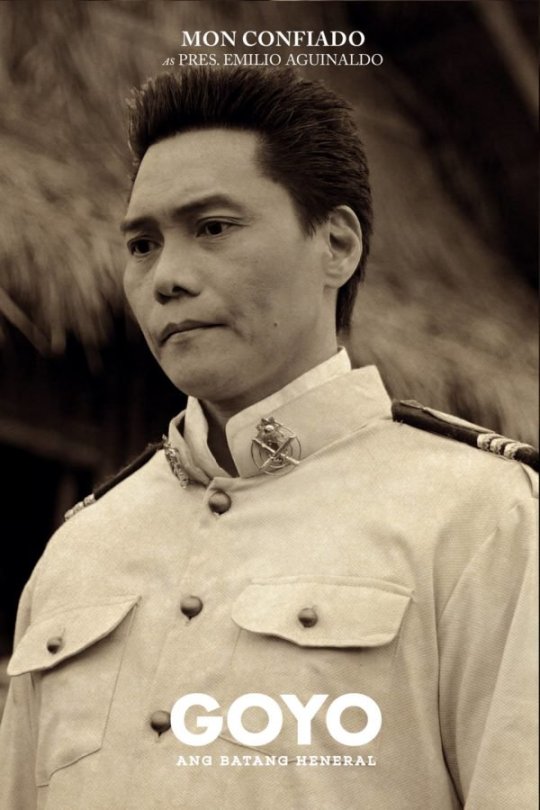
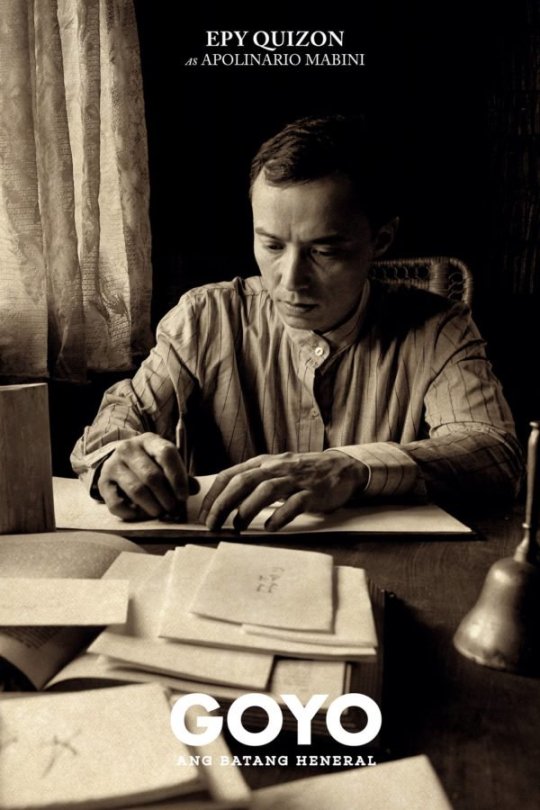
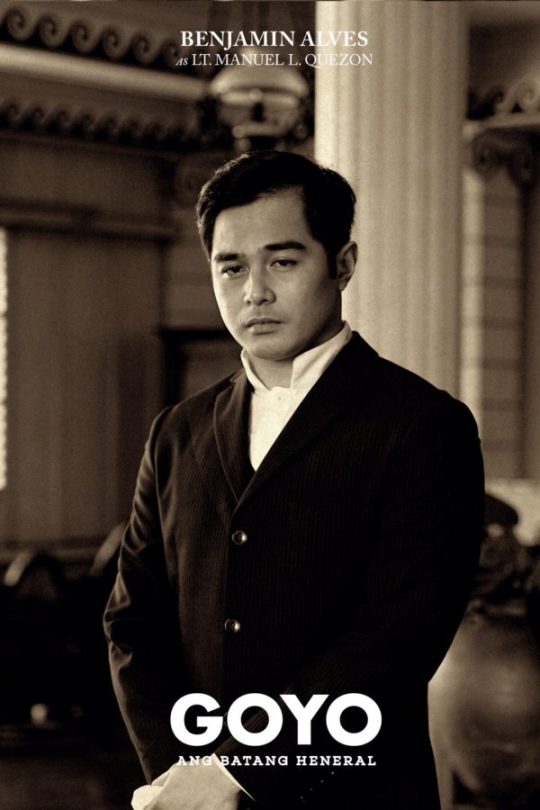
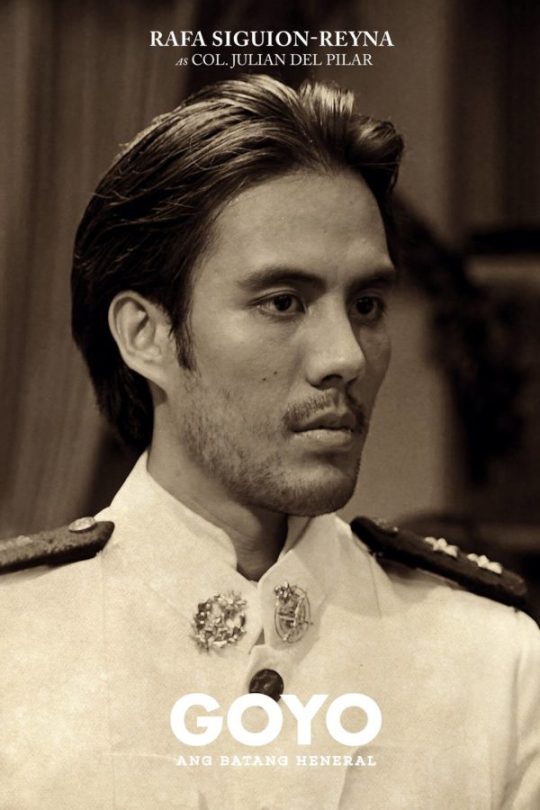
Rafa Siguion-Reyna steps up as Goyo’s brother Julian del Pilar.
The general’s love interests include Emilio Aguinaldo’s sister Felicidad (Empress Schuck) and his last love Remedios Nable Jose (Gwen Zamora).


Following the assassination of General Antonio Luna, the task of purging Luna's loyalists in the Philippine Army falls to General Gregorio "Goyo" del Pilar, a young, brash general and a favorite of President Emilio Aguinaldo. During a five-month break from combat, del Pilar and his unit, including his older brother Julian and his best friend Vicente Enriquez, capture Angel Bernal, the younger brother of Luna's former aides-de-camp, Manuel and José. Meanwhile, Joven Hernando, who now works for his uncle, is assigned to be del Pilar's photographer.
While the Philippine Army relaxes and the American forces prepare for a second attack, General José Alejandrino, a Luna ally spared from the purge, meets with Apolinario Mabini, who has since resigned from Aguinaldo's cabinet after the death of Luna. Meanwhile, Aguinaldo joins del Pilar in Bulacan and promotes him to Major-General of Pangasinan, while del Pilar begins to court Remedios, the elusive daughter of Don Mariano. During his time, Aguinaldo meets Mabini and offers him the post of Chief Justice, to which Mabini reluctantly accepts. Alejandrino travels to Manila to negotiate with General Elwell Otis and General Arthur MacArthur Jr., who reject his proposal. The hard march, coupled with daily American attacks, the pressure of having to escort Aguinaldo's family and tensions between soldiers of Luna's old unit take a toll on del Pilar, leading him to ignore an American attack that wipes out their rearguard and captures Aguinaldo's mother and son. The group soon arrive at Mount Tirad, where del Pilar devises a delaying strategy to buy Aguinaldo time to escape. Quezon surrendered to the Americans upon orders of his superior, General Tomás Mascardo, to be able to visit Aguinaldo to verify his capture and consult whether Mascardo should surrender. Aguinaldo instructed Quezon that the decision for Mascardo to surrender is up to Mascardo himself. Mabini is also captured by the Americans and exiled to Guam where he pens his own narrative of the war entitled La Revolución Filipina (The Philippine Revolution).
Personally, I loved Goyo but maybe that’s because I’m more aware of the events that transpired before, so I’m not ashamed to say I cried when I watched Goyo. Despite my love for this biopic about the popular Filipino hero, General Gregorio “Goyo” del Pilar. The movie had certainly provided us a real image of our past. Each on how we had tried surviving at some stage in the battle generation and the way we nonetheless manage to maintain the romantic "us" for the duration of those times. It was a fantastic possibility to have felt being round within the 1800's and visually experience how lifestyles was then. the film resonates with us Filipinos these days. let us be like Goyo, who fought till the cease, no matter the warfare, but at the equal time, allow us to analyze from him, understanding how blind we are to powerful people portraying themselves as heroes so that on the cease of it all, our combat will were really worth something. it's far contemplative and eye-awakening - "Goyo" makes a person mirror on his/her true stand in social and politic affairs - subjects in an effort to necessarily strike someone however indifferent he/she may additionally appear, or but committed he/she can be for a positive cause. The film sends a robust message to nevertheless be intact with the ever-noble virtue of patriotism; to stand firm no matter the seemingly robust tide leaning closer to blind adherence to a pacesetter or determine, under the guise or cloak of fake patriotism. The movie's purpose may be said to be similar to "Heneral Luna" however with a extraordinary method. It gives special views and exceptional attitudes of characters faced with similar conflicts. All in all, the film is a ought to-watch - educational, notion-evoking, opportune, and attractive.
The lessons learned in this film are as timely as today's event.Perhaps the saying "Those who do not remember the past are condemned to repeat it " is inescapable.
0 notes
Text
Review:AFTER ALL THAT HAPPENED MEMORIES WILL REMAIN
Jerrold Tarog's historical film"Heneral Luna" portrays the war of the Philippines against the Americans.A short tempered Filipino general faces their enemy formidable than the American Army.
The film shows if how the whole presedential cabinet are debating about the presence of the American in our country.Heneral Luna wants that the American must leave in our country,he know that the American desire is to seize the Philippines.
But there are some cabinet members prohibitive if what luna wants happen to the American including Felipe Buencamino (Nonie Buencamino) and Pedro Paterno(Leo Martinez) they want to trade with the American so that our economy were flourish.They give more value on business than the sake of our country.
Despite of prohibitive luna and his trusted comrades General Jose Alejandro,colonel Francisco"Paco"Roman(Joem Bascon),captain Eduardo Rusca(Archie Alemania) captain Jose Bernal(Alex Medina) and major Manuel Bernal(Art Acuña) embark on an arduous campaign against the invading American forces.
The cinematography is great every shot,every angle,and every motion of the camera is beautiful.The images on the big screen is clear and there is one scene that you have to look out for, the flashback sequence to the generals youth.It helps a lot on a movie to make more realistic.
John Arcilla is perfect on his role as heneral luna the way he acted and his penetrating gaze it intensified the effect to the viewers.He is the brave leader that did not hesitate to fight for our right.
For me the most intense and unforgettable events that happened in the film,as a Filipino is the scene in Cabanatuan where luna was shot,stabbed,and hack repeteadly to death.I sad to say that luna died in the hand of his fellow Filipino.
I recall in the beginning of the movie the Philippine flag was very clean.At the end of the film ,it burned.I think because we can say that, we success against the American but we failed in our fellow Filipino.
This film is served as an inspiration for the new generation to be a good and true leader.It is also reminds to us ,as a Filipino for being hero of Heneral Antonio Luna.
0 notes